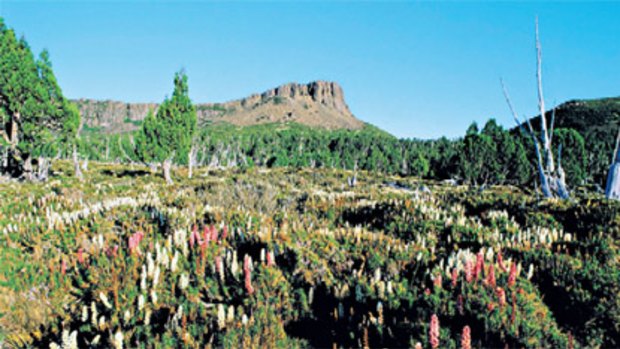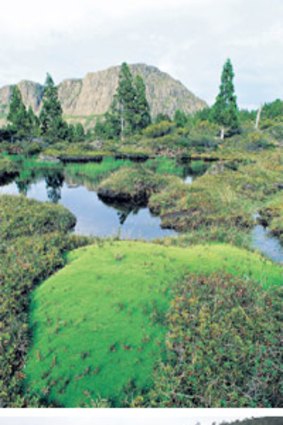
The Walls’ distinctive alpine landscape.Credit: Louise Southerden
Louise Southerden enters the natural alpine fortress of the biblically inspired Walls of Jerusalem National Park.
Bathroom scales are not to be trusted. Not when you're trying to lose weight, of course, and not when you're psyching yourself for a full-pack trek in deepest, remotest Tasmania and you decide, on a whim the night before you leave, to weigh the pack you'll be carrying for the next six days.
Nevertheless, after adding a few final items supplied at our trip briefing in Launceston that afternoon (a Gore-Tex jacket here, a sleeping mat there), I lift my pack on to the scales in my hotel room. Fifteen kilograms had been my limit during pre-trek training; at thisweigh-in,my pack is only 14 kilos. But that's before half a tent is added (my tent-mate will carry the other half) and the three-kilogram food bag our two aptly named guides, Victor Traill and Steve Trudgeon, have promised to give each of us the next morning.

Bible study ... cushion plants dominate the vista;walkers traverse a button-grass plain.Credit: Louise Southerden
It's a three-hour drive from Launceston to the start of our trek, a join-the-dots journey through Deloraine and Mole Creek, past honey farms and wildlife parks to the middle of Tasmania, so there's ample time for anxiety to set in. It doesn't help that Traill has told us the hardest part of this six-day walk is the beginning: a two-hour uphill slog in the heat of the day, just after lunch, with our packs as heavy as they're going to get.
After a picnic by the rushing Mersey River, we put on knee-high gaiters (to protect our legs from spiky scoparia bushes; Trudgeon says they also make you feel "at least 20 per cent tougher") and shoulder our fully laden packs for the first time. It's then I discover something those bathroom scales didn't indicate: packs don't feel as heavy once you're moving. Sure, it takes us two hours to cover the first two kilometres to Trappers Hut - a replica 1940s possum-trappers' refuge - and one of my fellow walkers overheats and throws up but the guides are good at distracting us by pointing out pretty pink mountain berries, yellow dogwoods and Clumner Bluff.
Still, it's easy to see how such a start could, and does, discourage less-prepared visitors.
Despite being right next to the ever-popular Cradle Mountain-Lake St Clair National Park, Walls of Jerusalem National Park is an oftenoverlooked piece of Tasmania's natural heritage; the girl-next-door to Cradle's screen siren. Not that the Walls is plain, and many Tasmanians, including Traill, regard it as their favourite park. It gets fewer visitors than its better-known neighbour: about 3500 annually, compared with the 170,000 people who visited Cradle Mountain last year (including 8084 who tackled the famous Overland Track).
Why so few? For one thing, there's no road access. The only way into the Walls of Jerusalem is on foot via the aforementioned two-hour slog - and that's just to get to the plateau; after that, it's another two hours to the campsite and the most scenic section of the park.
It's also Tasmania's only true alpine national park and unlike, say, the Overland Track, where you climb to high points during the day and retreat to lower huts or campsites at night, most of theWalls of Jerusalem lies above 1200 metres, so you're more vulnerable to extreme weather, which can come at any time. Summer snowfalls are not uncommon - there's ice on the tents one morning of our trip in early February - and every day we carry rain jackets, thermals, fleeces and beanies because, as Traill puts it, "the weather can change up here like flicking on a light switch".
Of course, that's all part of the adventure and the fact that the Walls isn't as popular as some other parks in Tasmania is one of its chief attractions. My seven companions and I have come from all over Australia seeking what Tasmania promises in spades - and delivers in double spades here: a way to escape the human-centric world for aweek. It's the kind of place where, if you're up for a challenge, you're in for a treat.
One of six national parks that make up the 1.35-million-hectare Tasmanian Wilderness World Heritage Area - which includes Cradle Mountain-Lake St Clair and Franklin-Gordon Wild Rivers national parks - the 51,800-hectare Walls of Jerusalem puts the "wild" back in "wilderness". Its landscape was created by grinding glaciers thousands of years ago and features dolerite monoliths and fortress-like walls, fairytale forests of pencil pines and broad valleys that glitter with tarns (theWalls and adjacent Central Plateau Conservation Area contain almost 4000 glacial lakes and tarns).
It's also ideally suited to base-camping - carrying in everything you need, setting up camp on the plateau and exploring without packs on subsequent days.
That's how we come to abandon our packs on our first morning in the park - two of our six days involve day walks - to explore the Walls. It feels a bit like a Sunday-school excursion at first, thanks to the biblical names bestowed on the landforms around us by two pious men: surveyor James Scott in the summer of 1848-49, and Launceston solicitor and keen bushwalker Reg Hall in the 1920s.
Two-plank boardwalks lead us through a pass called Herod's Gate, past Lake Salome and between King David's Peak (1500 metres, on our right) and Zion Hill (1395 metres, on our left).We stop to admire their reflections in the peaceful Pool of Bethesda before strolling on to Damascus Gate. Here, we leave the track to scramble up a scree slope and through a slot canyon to the top of Solomon's Throne (1450 metres), which gives us a view of some of the high points on the Overland Track - Cradle Mountain, Barn Bluff and Mount Ossa - just 40 kilometres to the west as the raven flies.
Of course, the Walls of Jerusalem's landforms are much older than even the ancient city of Jerusalem. As we look down on the valley we've just walked along, Traill gives us a brief lesson in glaciology. When the last ice age peaked, he says, everything below us was covered by the largest ice sheet in Australia - 100 metres thick in places.
Now the Walls is littered with telltale signs of its icy past: mountains as flat as tabletops because their crowns were worn away by ice; low hillocks called glacial moraines, where glaciers once bulldozed the earth; and, underground, highly flammable peat, which formed after the glaciers retreated (the reason campfires are banned).
To help us travel even further back in time, Traill places a few of our trekking poles end-toend on the ground in front of us - to represent 45,000 years of Aboriginal culture in Tasmania. "Here," he says, walking to the far end of his timeline and pointing to a spot five centimetres from that end, "that's when white man came to Australia.
In that last five centimetres, 45,000 years of Aboriginal culture was lost." Today, sadly, there are no records of even Aboriginal names for features in the Walls of Jerusalem, so we take a few moments to acknowledge the people who called this place home long before glaciers, pious surveyors and walkers made their marks. A wedge-tailed eagle soars below us.
Back down on the plateau, we stroll to Dixon's Kingdom. This dark, eerie pencil-pine forest - with its cubby-house hut made of weathered wood - is named after trapper and grazier Reg Dixon, who first came here in the 1930s and allegedly saw a Tasmanian tiger nearby in the '60s, long after the last thylacine is believed to have died in captivity in Hobart Zoo in 1936.
Some days, we travel across the park, often leaving the marked trails, to explore remote and seldom-visited areas. "One of the great things about the Walls," Traill says, "is that Parks Tasmania doesn't discourage off-track walking as it does in other parks."
It's refreshing to walk in a national park where you don't feel regulated at every turn. Of course, that puts the onus on us to travel responsibly - which is easier when you have a guide. Whenever we come to soft ground, for instance, Traill, in the lead, reminds us to fan out to minimise the impact of 10 pairs of hiking boots on the plants underfoot. And we carefully sidestep cushion plants - low, lurid-green blobs that can cover several square metres; each one is a colony of symbiotic species, much like the polyps that make up corals - and just as fragile.
Twice we camp beside lakes. Once we swim, at Lake Meston, where the water is especially clear and inviting after a hot day of walking. It's warm, too, at least where it's ankle deep; when we're waist deep, we decide we've come too far to retreat so we dive in - and all resurface gasping and yelping. I shiver back to the shore and as I'm wriggling into thermals, it strikes me that it's not every day you get to swim (albeit fleetingly) in a remote glacial lake in alpine Tasmania.
Later that evening, we return to the lake's beach at sunset and listen to frogs talking to each other, like squeaky hinges. To round off a perfect day, Traill, head chef as well as trip leader, surprises us after dinner with dessert: homemade chocolate mousse chilled in the lake. Dinners aren't often a highlight on hiking trips but night after night, our guides present us with treats - from risotto and udon noodle dishes to apple crumble and miso soup - magically conjured from ingredientswe've carried in our packs.
On our last morning, after negotiating a vast maze of button grass and following a narrow track off the plateau, we arrive at Mersey Forest Road, further south than where we began almost a week ago. On our way back to Launceston, Traill mentions that we can again see some of the Overland Track's high points. Cradle Mountain and its legendary walk really do dominate this part of Tasmania but they can't tempt us now. The wild Walls of Jerusalem and its fair-weather fairies, which have smiled on us all week, have won us over.
Louise Southerden travelled courtesy of Tasmanian Expeditions and Tourism Tasmania.
FAST FACTS
Hiking there The Walls of Jerusalem is in central Tasmania, three hours' drive west of Launceston. Tasmanian Expeditions has several walking trips in the national park, between October and May, including the six-day Walls of Jerusalem Circuit, which costs $1695 a person from Launceston. The cost includes two guides, transfers to and from the track, all meals, camping gear and some hiking gear (waterproof jackets and pants, gaiters, backpacks, trekking poles). Some pre-trek fitness training is recommended. Phone 1300 666 856, see tasmanianexpeditions.com.au. For more information, see discovertasmania.com.
Staying there City Park Grand Hotel, a heritage-listed boutique hotel across the road from the Boag's brewery, has rooms from $130 a night; see cityparkgrand.com.au. The Sebel Launceston, close to the newly developed Seaport, has suites from $189 a night; see mirvachotels.com/sebel-launceston.
Sign up for the Traveller Deals newsletter
Get exclusive travel deals delivered straight to your inbox. Sign up now.